Caterpillars are butterfly larvae that come in many different shapes, colors and sizes, but the damage they do is always the same.
They ingest plant leaves and pine needles as they feed, and thereby wreck often irreparable damage in the garden and in the vegetable patch.
Read also:
Are there any effective organic caterpillar treatments?
Many chemical synthetic products have been developed that are quite effective in destroying the pests.
But, alas, the products themselves are often toxic for the environment and their use must be foregone because, today, many organic treatment have appeared that are very effective.
Here are several organic caterpillar control options that aren’t a problem for the environment at all:
- 1 – BT products – predator pest control of the microscopic sort. Learn all about BT here.
- 2 – Caterpillar predator animals – insects & animals that eat caterpillar eggs or disrupt their life cycle
- 3 – Manual picking – cleanest possible option. Requires daily follow-up.
- 4 – Prevention – nets & traps against adult egg-layers and caterpillars
- 5 – Horticultural oils – oils that smother and choke eggs and caterpillars
- 6 – Decoy plants and decoy objects – also the cleanest option. Attract caterpillars away from target plants
- 7 – Companion planting and crop rotation – make it hard for pests to spread, maximize companion planting
Each of the above is presented in the sections below (numbers are simply there to help you navigate the page easily). There isn’t any “better or worse” strategy, and you’ll likely end up using a combination of most.
Also, if you’re only dealing with the occasional caterpillar, perhaps it’s all right to let it feast and grow. It may turn into a wonderful butterfly. Try looking up what type of caterpillar it is.
1 – BT sprays, use microbes against caterpillars
Products based on Bacillus Thuringiensis are authorized for use in organic growing and only have a very reduced negative impact on our planet.
- Generally, they can be found in horticulture stores under the label “Organic caterpillar killer“.
- Usually they must be dissolved in water and sprayed.
- These products must be ingested by the target insects and must thus be sprayed on the entire plant.
- Anti-caterpillar treatments must be applied as soon as the first butterflies fly.
- Treat during dry weather, with no wind and no risk of rain.
- Repeat every three days until caterpillar populations are under control.
BT spares most beneficial insects. It breaks down within a couple days due to ultraviolet rays and water.
BT works by blocking digestion in the caterpillars, which can’t eat anymore. It can take two or three days for caterpillars to consume their reserves, after which they die without turning into moths.
2 – Caterpillar predator animals
There are a host of insects and animals that will either eat caterpillars outright or parasite them. These predator animals are a great option because target pests cannot develop resistance to them, as they would to chemical treatments.
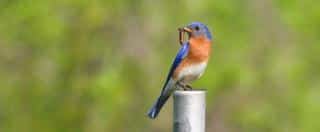
Ladybugs against caterpillars
We’re all familiar with how ladybugs help against aphids, but these little Our Lady’s Bugs also eat caterpillar eggs when they come across them. Young, newly hatched caterpillars are a choicy snack, too.
Birds against caterpillars
Garden birds love eating caterpillars. Even ugly, hairy, colorful ones are often gobbled up in hungry beaks.
Parasitic wasps
Trichogramma is a genus of wasps that lays eggs inside caterpillars. After hatching, they eat the pest out from the inside and keep it from turning into a butterfly.
Not all parasitic wasps are beneficial, though. For example, the citrus wasp is a type of gall wasp that attacks plants directly, not other insects.
- Citrus wasp and Gall wasp can also be controlled with many of the methods listed here for caterpillars.
Trichogramma are bought in massive amounts. For example, between 50,000 and 200,000 individual wasps are recommended to treat one acre of infected gardens. Ideally repeated weekly.
Chickens and caterpillars
Chickens love eating many kinds of caterpillars. Sometimes they have to be “taught” to like them though. Chickens which have been fed grain and housewaste aren’t always adventurous when it comes to “new” food. Not all caterpillar types are healthy, though.
- To teach them to broaden their diet, give them time to “free range” around the garden.
- Add the caterpillars to their feed daily for a couple weeks. Chop them in half first (the caterpillars, of course).
- Dry the caterpillars out before feeding them to the chickens.
Once they’re familiar with that particular caterpillar type, you can release them in your vegetable patch for a short while.
- Chickens always go around the garden in laps. First lap is always for bugs, snails, slugs. Second lap is when they start going for leaves and shoots. After that, they start scratching around for more grubs.
- Best is to release them about twenty minutes before roosting time. They’ll have time for the first lap and eat the caterpillars, but will turn home to sleep before digging into your veggies.
Learn how to set up a chicken coop
Note: this also works with ducks
Other insects and animals
There are quite a few more animals and insects that have caterpillars on their daily menu.
Hedgehog is one of them. They also help get rid of slugs and snails, too. Green lacewing is an insect that is a great help because it eats all manners of eggs, caterpillars, larvae as it grows. Adults pollinate plants, too. Not to forget are frogs, toads, different types of rodents, several varieties of spiders…
3 – Picking caterpillars manually
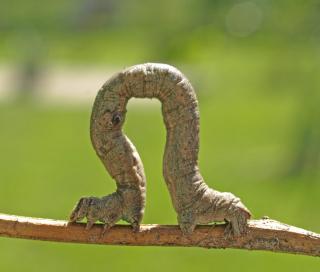 This is of course the cleanest way of removing caterpillars from your plants.
This is of course the cleanest way of removing caterpillars from your plants.
It’s fairly time-intensive when caterpillar populations explode. However, if you make it part of a daily or weekly routine, you can quickly pick most caterpillars off before they do any real damage.
Simply going around your garden every couple days will let you avoid any serious contamination.
How to pick caterpillars by hand
- Hand-pick caterpillars with gloves. Thin gloves work better than thick thorn-resistant ones.
- Alternatively, you can hold a jar under the caterpillar and nudge it with a twig or popsicle stick, it will fall right in.
- Some caterpillars gather in nests (at night, or at certain stages in their development). Be sure to detach and destroy these!
- Best time to pick caterpillars is early evening or dusk. Next best time is early morning, while there’s still dew everywhere.
What can you do with caterpillars?
- some caterpillars might be of a rare or endangered species, like monarch butterflies for instance. Try to keep these and feed them until they reach cocoon stage.
- feed them to your garden chickens
- drown them in a bucket of water (toss the water in the compost pit when they’re dead to recycle their nutrients)
- dry them out in the sun in a jar closed with the lid. These dried caterpillars are great for feeding birds and chickens. They’ll keep until winter if well dried and stored.
- Chop them up or squash them underfoot.
4 – Physical prevention against caterpillars
Caterpillars hatch from moth and butterfly eggs. You can protect against mothers laying these eggs on your plants in different manners.
Fence out moths and butterflies
- Set up fine mesh netting around your plants. Horticultural fleece or mosquito net material is often enough. It may also go under the name “insect barrier“. Note, however, that you’re also blocking out beneficial pollinators. So if you’re hoping for fruit from plants that must cross-pollinate, you’re going to have to remove the netting during flowering.
- Grow your most vulnerable plants in a greenhouse. You can release pollinators in the greenhouse and keep moths and butterflies out.
- A simpler in-field option is to sow plants under cover.
Landscaping obstacles to hinder insect flight
Insects often have trouble navigating around obstacles. Additionally, they serve as windbreakers which means insects aren’t carried around as far.
- Plant a hedge around plants you wish to protect. A hedge along the perimeter of the garden will reduce the distance an insect can fly.
- Low-lying hedges are useful, too. Some insects only average a flight height lower than two feet. To them, a low hedge is a wall they must circumnavigate.
- Fences, walls, and treillis in a vertical garden are effective, too.
- A raised garden is easier to control. Insects usually hover at target height for leaves of shrubs they infect. A raised bed disturbs that. Additionally, leaves are easier to inspect.
Moth trap, trapping butterflies
It’s possible to find moth traps and butterfly traps that won’t release the insects.
- Some use a light source (like a bulb) to attract them. This is especially effective for night moths.
- Others use pheromones, which replicate mating calls and lure male insects to the trap. That way, they can’t find the females, which have a harder time mating.
- Another tip is to always have a butterfly net at hand. With a little practice, it’s easy to swoop down on moths and butterflies. Every one you catch is that many eggs that won’t hatch into caterpillars. Bug zappers work too, but they’re battery-powered.
Traps to catch caterpillars
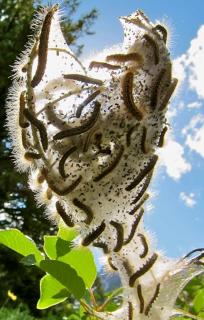 An alternative to hand-picking them is to lure them all together, which makes catching them easier. In short, you want to replicate conditions that will attract a nest.
An alternative to hand-picking them is to lure them all together, which makes catching them easier. In short, you want to replicate conditions that will attract a nest.
- Like slugs, caterpillars love cool, moist places during the day. Lay a slab of old wood down on the ground. When you turn it over the next day, scrape and collect all the slugs and caterpillars off the underside. They thought it would be a cool, safe spot for them to spend the warmest hours of the day.
- A rag or cloth wrapped around the stem of the shrub or trunk will also attract caterpillars in the same manner. Visit the trap daily.
- It’s also possible to ring stems and trunks with a glue trap that will catch any caterpillars trying to cross up and down it.
Against the devastation of oak processionary or spruce processionary worms, it’s possible to create a trap that will collect the thousands of caterpillars as they march down from infected trees, preventing their spread to others!
5 – Oils and soaps against caterpillars
It’s difficult to find sprays that will only target caterpillars. Usually, the following will get rid of pests like caterpillars, aphids and red spider mite. However, they’ll often remove beneficial insects, too.
- These are to be sprayed on the topside and underside of leaves, and along stems, too.
- Spraying on the ground up to a foot (25 cm) around the stem will protect the tree or plant from caterpillars that wish to climb up it.
- Never spray during warm and sunny hours. Prefer dawn or dusk. Water drops would burn the leaves like a magnifying glass.
Neem oil to kill caterpillars
- Neem oil (oil pressed from neem fruit) is a potent insecticide and insect repellent.
- Dilute 2 ounces (3 centiliters) of neem oil in a gallon of lukewarm water (4 liters).
- Spray in the evening.
- Neem oil will suffocate the caterpillars and they will die off within hours.
Note: Neem oil will kill bees, so only spray at dusk, when bees have returned to the hive.
Soap spray
- Mixing spray prepared from lukewarm water and mild soap (two tablespoons to a gallon) will interfere with the caterpillar’s breathing.
Plant extracts to repel caterpillars
For one liter (one quart) of natural caterpillar repellent, add a combination of the following:
To extract the active compounds, you can either:
- blend the mixture and let it sit for 24 hours, then filter it (keep the juice, discard the pulp).
- or, boil the chopped plants for 30 minutes, let it sit and cool down. After that, strain out the spent plant materials, keeping the liquid preparation.
A specific variant of this is the garlic decoction. To a certain point, several fermented tea recipes can help against caterpillars, too, especially rhubarb fermented tea.
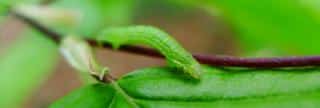
6 – Decoy techniques against caterpillars & moths
Moths and butterflies can also be tricked! Optical illusions will make them think a certain spot is taken. Let’s take a look at some of the tricks that would certainly trick us as well, if we were moths!
Decoy crops (also called trap crops)
Some crops can be protected if sacrificial crops are nearby. Typically, nasturtium is a favorite of many moths and butterflies. Having this climbing plant growing from an barrel nearby will attract egg-laying moths to it. Your own crops will remain unscathed!
Some great decoy crops that lure caterpillars away:
Best is to check on these decoy plants first and remove caterpillars from them as soon as you see them.
Decoy objects
You can trick moths and butterflies into laying their eggs further off!
- Sometimes printing out drawings that are similar to those of the female moth and attaching those life-size images near the target plant is effective.
- Indeed, moths naturally try to space out their offspring and will pass their way if they notice too many “competitors” on a given plant.
A traditional practice is to hang half-eggshells upside down at leaf height in vegetable patches and fields. Supposedly, moths lay their eggs in the underside which naturally forms a sheltered dry and wind-free spot. Only thing left to do is to check the undersides and remove any that have eggs under them!
- However fun this eggshell hanging sounds, I have yet to see that this effective. It’s a traditional practice, but no proof has ever been provided that it works!
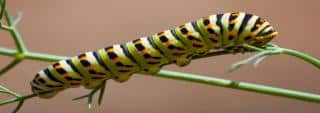
7 – Crop rotation and companion planting
Caterpillar larvae hatch after spending the winter in the ground or in secluded areas. Certain plants are also known to repel insects, and moths or butterflies in particular. Let’s see how using plants around the garden can help protect target plants, in addition to decoy plants (see above).
Crop rotation against caterpillars
Many of the most problematic caterpillars have a simple life cycle:
- They hatch on the plant and eat from it
- They descend from the plant and directly tunnel into the ground
- Underground, they turn to pupae and finally hatch again
If crop rotation is practiced, fresh pupae hatch from their cocoon but can’t easily find new host plants when they emerge.
Additionally, crop rotation helps plants grow healthier. Healthy plants can resist caterpillars better.
Greater biodiversity
Having a high amount of different plants will have several beneficial consequences against caterpillars, too:
- A mixed hedge naturally includes appealing traits for caterpillar-eating animals, as seen above: food, shelter, nesting, and more. This attracts caterpillar predators. A protective hedge will do just as well.
- Target host plants are further apart, sometimes even too far to reach for the moth or butterfly.
- Greater chance of the insect laying eggs on a non-ideal host. Eggs hatch but caterpillars can’t reach maturity.
Plants that repel caterpillars
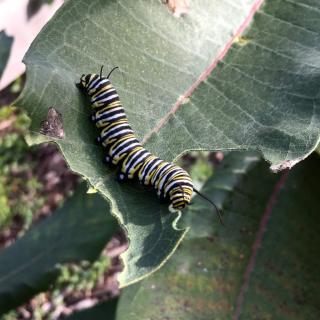 Aside from decoy plants that attract caterpillars, there are also a set of plants known to repel most types of caterpillar insects.
Aside from decoy plants that attract caterpillars, there are also a set of plants known to repel most types of caterpillar insects.
Smart tip about caterpillars
Some caterpillars are definitely pests, while others will grow into beautiful butterflies.
Get to know those that are most common in your area! For example, a famous visitor in the vegetable patch is the cabbage white.
Some may also be endangered species, which you can protect instead of killing them.
Read also:
Written by Gaspard Lorthiois | Loves helping out, especially when it comes to growing things. Worked in herbal medicine, runs a farm, and dabbles in tech. Master's degree and engineer.


 This is of course the cleanest way of removing caterpillars from your plants.
This is of course the cleanest way of removing caterpillars from your plants. An alternative to hand-picking them is to lure them all together, which makes catching them easier. In short, you want to replicate conditions that will attract a nest.
An alternative to hand-picking them is to lure them all together, which makes catching them easier. In short, you want to replicate conditions that will attract a nest. Aside from decoy plants that attract caterpillars, there are also a set of plants known to repel most types of caterpillar insects.
Aside from decoy plants that attract caterpillars, there are also a set of plants known to repel most types of caterpillar insects.
Do orange lily bulbs around pear tree roots harm the fruit, like make it bitter ? These look like daylilies very hardy and prolific.
Can you suggest an organic procedure to destroy these killers? Like natural way to kill these catter pillars?
Hi Hassan! I added a few more techniques to control caterpillars naturally. Hope you find them useful!